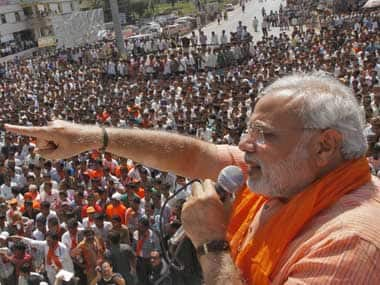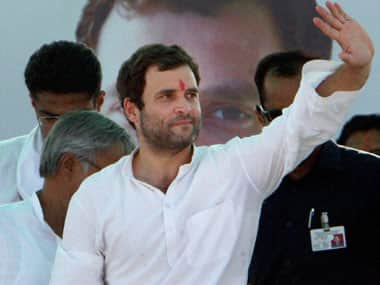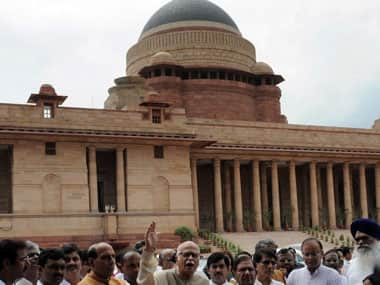By Percy Mistry If Rahul Gandhi (RaGa) cannot cut the mustard to lead India in 2014 (a conclusion that most of the Indian electorate seems to have reached already, if prematurely, judging from public discourse involving taxi-drivers, domestics and others), can NaMo do that in delivering India from the non-inclusive, low-growth, ‘stagflation’ trap it is now in? Can he restore India’s lost credibility (especially that of its government) not only in the eyes of his countrymen, but of the outside world in general, and of foreign investors in particular? Globalised India needs the support of both; far more than its ignorant ante-diluvian politicians, stuck in the autarkic, socialist murky mindset of the 1970s, seem to realise. [caption id=“attachment_1243891” align=“alignleft” width=“380”]  Reuters[/caption] In that respect, India is severely handicapped by having a lunatic Left; perhaps the polar opposite equivalent of the insane Tea Party right in the US. India’s erudite but clueless Left is unable to reconcile empirical reality distilled from around the world (including, most importantly, post-1980/90 China, Russia and the former Soviet bloc) with its bizarre adherence to a Utopian view of how an economy should work under state ownership, direction and control. The nonsense repeated continually about the Left offering an alternative to neo-liberalism is a non sequitur that needs to be decisively rejected yet again by the Indian electorate in 2014. Its ‘alternative’ would turn India’s economy into one similar to North Korea’s, Cuba’s or Venezuela’s. It will not turn India into Scandinavia. If India is to revive and sustain growth rates of 8 percent annually for the next three decades – as it must, to avoid being trapped permanently in lower-middle income status – it will need much larger inflows of foreign investment – both direct and portfolio - on an uninterrupted basis over that time. India can only attract such inflows if it reshapes entirely its bureaucratic, judicial and legislative systems that are oriented towards obfuscation and delay rather than permitting anything constructive to happen in real time. It will need to rid itself of the pervasively obstructive ‘Argumentative Indian’ approach that discourages rather than encourages high levels (around 35 percent of GDP) of domestic and foreign investment and instead permits business to be done with much greater ease and facility. Business must, of course, be run within strict rules of fair competition that are credibly enforced, without the Supreme Court having to step in and micro-manage the implementation of each and every decision. To do that the next elected government must reduce political, policy, currency, commercial and project implementation risks dramatically; especially if it is to offer investors (domestic and foreign) consistently higher risk-adjusted returns on capital investment than other competing economies can. If India can do that, then things like the tapering of the US Fed’s Quantitative Easing ((QE) would not matter much, except perhaps at the margin. Under overall economic mismanagement by UPA-2’s PMO and the Planning Commission, fiscal mismanagement by Pranab Mukherjee, and monetary mismanagement by the affable Duvvuri Subbarao, all five risks have increased exponentially in the last five years. RaGa obviously cannot reduce those risks because he believes UPA-2 has made no mistakes; it has only credits, no debits to its performance. That implies he does not know what he is talking about and has no idea about what needs to be done next. Moreover India’s patience is exhausted with the endemic corruption that is now the brand and hallmark of UPA-2 – paradoxically in the reign of an honest PM! If UPA-3 somehow defies the odds and returns to power in 2014, the political certainty is that the corrupt looting in 2014-19 will continue on a scale that is unimaginable. It will make what has happened between 2004 and 2013 look almost like a mild preview trailer of the real action to come. The question for 2014, therefore, is: Can NaMo reduce these five risks to more acceptable levels in the next five years? Does he understand what needs to be done and the wide, deep reforms that need to be made – other than hearing it from his coterie of Gujarati industrialists who have their own rapacious crony-capitalist interests at heart, rather than genuine concern about levelling the playing field for all and for the wider economic well-being of India. Can NaMo provide those economic reform assurances to outsiders as well as assure stability, communal harmony, peace and stability with our neighbours to whom he is so publicly hostile and offensive? Or will he destabilise India’s hard won but fragile internal harmony which is always bubbling with regional and ethnic discontent? Will he assuage and ameliorate those tensions or aggravate them? Many are adamant that he can do all that is necessary and good based on his record. But a close look at that record is far from reassuring. If it were, NaMo would not need to resort to as much exaggeration, embroidery and embellishment in making taller than factually supportable claims about what he has achieved. To be sure he has achieved much; as has Gujarat under his prolonged political and administrative leadership. But those achievements have not been as spectacular, nor as unique, as he and his team beat their drums so loud and frequently about; thus drawing attention more to their failings than their accomplishments. When it comes to the average Indian, NaMo still projects a somewhat crude and frightening figure despite the tutored attempts he is making to soften the edges and round out the sharp angles of his obviously indomitable persona. He exemplifies a sinister communal threat. His claims about his post-Godhra achievements for Muslims in Gujarat ring hollow. It is not that he refuses to apologise for the unforgivable ‘mistakes’ he made on his watch with genocidal outcomes in 2002 – mistakes that are now being conveniently exonerated by all kinds of authorities being brought out of the woodwork. [caption id=“attachment_1243903” align=“alignleft” width=“380”]  Rahul doesn’t think UPA 2 has done anything wrong: PTI[/caption] Too much is made of such apologies. They do not really mean very much. Those who believe in NaMo believe fervently that he has learnt from 2002 and has changed. But if that comes across to true believers, it has still not come across to India at large. The majority of its Muslims probably still feel they have much to lose from his ascendancy. And it is almost impossible to convince them otherwise; especially not in the language of NaMo feeling sorry for puppies being run over by cars. NaMo has other chinks in his armour as well. There is no evidence in his record as CM of Gujarat that he is capable of running a collegiate, consensual, Cabinet government that includes dissenters in his own party or leaders of other parties who will want their pound of flesh for extending support. Running the assembly in Gandhinagar is an entirely different proposition from running the Union parliament and a government in Delhi. The impression he conveys is to the contrary: “My Way or No Way”. Will that work in post-2014 India despite the strong but subliminal yearning of the electorate for a strong man to replace the weak ditherer, and seemingly disinterested onlooker, that it has as its PM now? The other NaMo weakness is his propensity to play fast and loose with facts and history. Yet another is his convoluted and inexplicable attempt at trying to resurrect and appropriate the legacy of Sardar Vallabhbhai Patel (SVP) and reinvent himself in that avatar of India’s unshakeable strongman. It is not difficult to see why NaMo has invoked and invited that particular ghost into current political discourse. SVP was an indomitable spirit of great and uncompromising principle, vision, forthrightness, simplicity and the toughness to make people bend to his will in the greater good of the country. NaMo is no SVP. RaGa is no Nehru. Moreover SVP would have been mortified to know that NaMo wants to spend over Rs 2,055 crore on erecting a statue taller than all others, thus offering an amazing target for every errant pigeon and crow in that particular neighbourhood. The frugal, spartan SVP would have wanted that kind of money to be much better spent – probably on the equalisation of opportunity and access to essential social services like education and health for Gujarat’s and India’s Muslims. To be sure, in raising the issue of SVP he has prompted Congress to try to claw SVP back to their bosom as a dyed-in-the-wool Congressman. That belated attempt at reclaiming SVP and other political giants of the Independence era who were equal to, or better than Nehru, shows how bankrupt the Congress Party has become in its base and sycophantic obeisance to just one family. That family has conveniently airbrushed all but its own members out of every depiction of Indian political history since Independence. NaMo may thus have done India, Indian history, and students of it, an unintended service by trying to appropriate SVP’s legacy; even if he ends up appropriating his legha instead. And he may well be right in implying that had SVP instead of Nehru been India’s first Premier, better political, economic and foreign policy choices might have been made. But counterfactuals, by their very nature, are impossible to prove or assert without risk of refutation. Besides, SVP died too soon. He did not live long enough to stamp his imprint on Indian choices and policy in the way that Nehru had the occasion, opportunity and longevity to do. What is unarguable is that most of Nehru’s choices – seen in the 20:20 hindsight of history unfolding – were wrong. His legacy is a confused, corrupt, unworkable, muddled, half-socialist, half-market, half-baked economy; a fractured polity that continues to unravel in the most venal fashion; and an incomprehensible foreign policy based on Utopian ‘non-alignment’. All three need to be overhauled substantively from root to branch. So, RaGa seems to be a non-starter. NaMo does not seem quite the ticket for India in 2014. Is there another option? Tragically, there is, in the form of a Third Front or whatever adjective is used before the noun ‘Front’. The most appropriate adjective would be ‘unworkable’. India has been there before. It has never worked. There is no possibility that it will work this time. Why? For obvious reasons. [caption id=“attachment_1243937” align=“alignleft” width=“380”]  AFP[/caption] India is (probably for all the wrong reasons, but mainly because of its legacy of being colonised by the UK rather than the US) a first-past-the-post, parliamentary system of democracy. It is not a US-style tricameral-cum-Presidential system of choice when it comes to electing the executive branch of government. The RaGa versus NaMo binary choice therefore offers a false and misleading option. Sadly, Indian voters can only vote for either in one parliamentary constituency seat each. To get RaGa or NaMo into power they have to vote for 543 other MPs – mostly local thugs, political satraps and sycophants, yet including a few (too few) people of intrinsic, individual merit. It is their aggregation that determines the choice of either RaGa or NaMo as PM. And, as the past has shown, most of the candidates for MP are not particularly attractive choices for voters at the ground level. Yet voters are obliged to vote for these non-entities in order to get the kind of government they seek. Unfortunately the continued, relentless progression of regionalism and fragmentation of the Indian nation, and of its electorate across 28 states and five Union territories, has inevitably ceded far too much political power to the extremely unworthy when it comes to exercising a national mandate or governing with a national agenda in mind. Most leaders of regional parties with significant voting strength in the Lok Sabha fall in the category of self-enriching, single-community or single-issue focused, self-empowering thugs and goons. They have a local power base secured and retained by a propensity to use mindless political violence that always goes unchecked by the forces of law and order. Many of these thugs and goondas wear sarees! They are not known for good governance, development or delivery of essential social and public services. They are known for criminality and pushing IAS officers around; especially those trying to do their jobs honestly. Their sole aim is to accumulate unbridled power to make money for themselves and their followers. Of course, there are exceptions like Nitish Kumar of the JD(U) and Naveen Patnaik of the BJD. And there is the Left which has the same propensities to violence when it suits, but which is fronted by perhaps some of the most erudite, intelligent and communicative people in the Indian political space. Pity they are always so profoundly wrong about India’s economics but so worryingly right when it comes to core social issues. The Unworkable Front option may well materialise simply because of the way in which the total MP seat numbers eventually fall. But it is impossible to see such a political configuration offering India a viable government with a charismatic leader, coherent policies, or a cohesive, coordinated Cabinet government. Taking all that into account the dispassionate observer, of how 2014 might unfold, is left with the conclusion that, with all his warts and faults, NaMo may be the ‘least worst’ option that Indian voters might wish to exercise in six months, taking the palpable risk that more overall good may come out of making that choice than any other. One can only hope that the MPs whom the BJP (and its allies in the NDA) selects to fight each seat are worthy of that ‘least-worst’ choice! The most logical option for voters confronted with these three appalling choices may be NOTA (none-of-the-above) or not to vote at all. But that’s not how democracy works. India’s voters cannot abdicate just because its government has! (Percy Mistry is a former World Bank economist and author of a widely acclaimed report on making Mumbai an international financial centre) (The first part of Mistry’s two-part article on India’s election trilemma can be read here )
Rahul Gandhi has no clue on how to rescue the country; the Third Front is unviable; there are doubts about NaMo’s acceptability to minorities. But he is the least of three not-so-appealing choices before the electorate
Advertisement
End of Article
Written by FP Archives
see more


)
)
)
)
)
)
)
)
)



